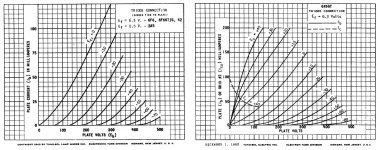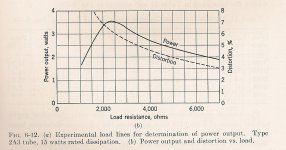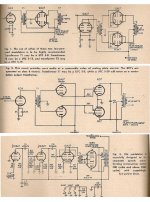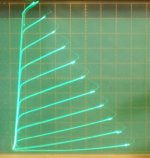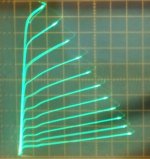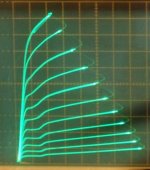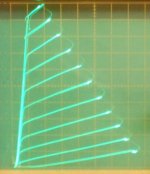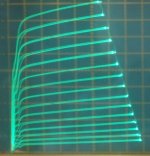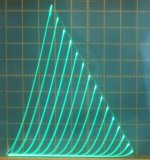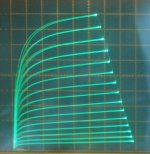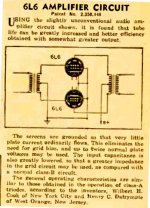I posted this question on another forum, but read some good content here so decided to join.
Still not confident in my ability to interpret old tube datasets, so I thought I'd just ask here. I have a pair of 6K6gt that need an output transformer. I am considering two designs: 1) push-pull with triode connections, 2) parallel single-ended with triode connections. Both designs keep me around 5 watts.
Regarding OT primary impedance, what values should I be looking for to accomplish each design separately?
Still not confident in my ability to interpret old tube datasets, so I thought I'd just ask here. I have a pair of 6K6gt that need an output transformer. I am considering two designs: 1) push-pull with triode connections, 2) parallel single-ended with triode connections. Both designs keep me around 5 watts.
Regarding OT primary impedance, what values should I be looking for to accomplish each design separately?
OPT for PP 6K6s either triode or pentode connected is safe at 10K P-P, 8K min.
PP 6K6s in triode will not get you 5W.🙂
PP 6K6s in triode will not get you 5W.🙂
Cut to the fish. Something like 1.4k 50mA in 2X single-ended, 11kct in push-pull. Neither are easy transformers to find.
And I'm getting numbers like 1.75 Watts total. (Respecting the 250V max in Triode, which may be conservative, BUT you only have two 6K6 so you don't want to be brave.)
6K6 is just not a good triode.
One 6K6 in Pentode will do 3-4.5 Watts. Wrap NFB around that and THD can be as low as the triode (or lower). But I don't want to dispute religion. Or whether 3W is much bigger than 1.7 Watts.
And I'm getting numbers like 1.75 Watts total. (Respecting the 250V max in Triode, which may be conservative, BUT you only have two 6K6 so you don't want to be brave.)
6K6 is just not a good triode.
One 6K6 in Pentode will do 3-4.5 Watts. Wrap NFB around that and THD can be as low as the triode (or lower). But I don't want to dispute religion. Or whether 3W is much bigger than 1.7 Watts.
OPT for PP 6K6s either triode or pentode connected is safe at 10K P-P, 8K min.
PP 6K6s in triode will not get you 5W.🙂
Why not 5W? The datasheet suggests nearly 10W for P-P pentodes under typical operation. From what I've read, triode wiring cuts power in half. What should I expect for power output under typical operation in triode?
Cut to the fish. Something like 1.4k 50mA in 2X single-ended, 11kct in push-pull. Neither are easy transformers to find.
And I'm getting numbers like 1.75 Watts total. (Respecting the 250V max in Triode, which may be conservative, BUT you only have two 6K6 so you don't want to be brave.)
6K6 is just not a good triode.
One 6K6 in Pentode will do 3-4.5 Watts. Wrap NFB around that and THD can be as low as the triode (or lower). But I don't want to dispute religion. Or whether 3W is much bigger than 1.7 Watts.
What do you mean by "not a good triode?" My application is a low power guitar amplifier. I like that triode mode gives me lower output and a smoother sound when pushed.
'Not a good triode' depends on the context.
Looking at output power, not all types behave the same when you tie the screen to the anode:
A single 6V6GT and a single EL84 both can put out around 5W when operated at 250V.
But as triodes at the same 250V, the EL84 gives 2W where the 6V6GT gets to a whopping 1W.
Not all datasheets list triode mode applications so you have to dig around several to find these.
How it sounds in guitar application is a whole different good/bad discussion 😉
Looking at output power, not all types behave the same when you tie the screen to the anode:
A single 6V6GT and a single EL84 both can put out around 5W when operated at 250V.
But as triodes at the same 250V, the EL84 gives 2W where the 6V6GT gets to a whopping 1W.
Not all datasheets list triode mode applications so you have to dig around several to find these.
How it sounds in guitar application is a whole different good/bad discussion 😉
A Comparison
There is nothing on the 6K6GT data sheets giving performance in triode mode. But a quick look at the 6F6 data sheet shews that within its max specs the 6K6GT looks a lot like a 6F6 in triode mode.
The 6F6 tests a magnificent 0.85W audio while dissipating more than 7.5W (250V, 31 mA). All that before losses in the OPT. Could push a little harder, increase the B+ to the dissipation limit & get a little more audio.
Another alternative would be to decrease the load impedance. But that would increase D% & decrease damping factor (DF). Refer to the 6A3 & 2A3 examples. The load impedance shewn on the 6F6 data sheet is already at the lower limit.
Good design sez load impedance should be at least 2X plate resistance (rp) & preferably even more.
The 6K6 is not a great choice for a triode SE amp.🙂
There is nothing on the 6K6GT data sheets giving performance in triode mode. But a quick look at the 6F6 data sheet shews that within its max specs the 6K6GT looks a lot like a 6F6 in triode mode.
The 6F6 tests a magnificent 0.85W audio while dissipating more than 7.5W (250V, 31 mA). All that before losses in the OPT. Could push a little harder, increase the B+ to the dissipation limit & get a little more audio.
Another alternative would be to decrease the load impedance. But that would increase D% & decrease damping factor (DF). Refer to the 6A3 & 2A3 examples. The load impedance shewn on the 6F6 data sheet is already at the lower limit.
Good design sez load impedance should be at least 2X plate resistance (rp) & preferably even more.
The 6K6 is not a great choice for a triode SE amp.🙂
Attachments
> What do you mean by "not a good triode?"
High plate resistance relative to its ratings.
They took a fairly mild triode and added a screen to bump-out the pentode curves a lot.
1.7 Watts of over-driven guitar is still plenty to annoy the neighbors. Someone here reported that 0.1 Watts could be "too much". Don't figure. Build it and see.
High plate resistance relative to its ratings.
They took a fairly mild triode and added a screen to bump-out the pentode curves a lot.
1.7 Watts of over-driven guitar is still plenty to annoy the neighbors. Someone here reported that 0.1 Watts could be "too much". Don't figure. Build it and see.
A very cheap way to test these small tubes that need a high plate load is the Bogen T-725 line output transformer. Unlike most line transformers, you can get a 10K, 19K, and 39K push pull load from them. I measured mine at - 3dB at 55 Hz at 1 watt. I've used them at 275 volts ish and 25 ma They are usually priced about $10-12 USD.
My notes reflect I got 3.125 watts out of a p-p pair of 6K6 at 10K with the T-725, the same power at 19K, but higher THD. I don't know if that was triode or pentode. Probably pentode.
OP might also consider 6G6 or the miniature equivalent 6AK6. 6G6 is in a very nice miniature shoulder bottle, and will put about the same power as 6K6.
My notes reflect I got 3.125 watts out of a p-p pair of 6K6 at 10K with the T-725, the same power at 19K, but higher THD. I don't know if that was triode or pentode. Probably pentode.
OP might also consider 6G6 or the miniature equivalent 6AK6. 6G6 is in a very nice miniature shoulder bottle, and will put about the same power as 6K6.
6G6G/6AK6 won't do much in triode, maybe 1/3 watt.
Rated 1.1W in pentode connexion.🙂
I always run 6G6 ... "hot". A push pull pair will do about 3.5 watts with a 10K load.
That is pushing real hard, must be in pentode.
Do the screens shew any red? Schematic with voltages, Etc?🙂
Do the screens shew any red? Schematic with voltages, Etc?🙂
No schematic, no angry screens, just a generic p-p cathode bias setup, built only for experimenting, so subject to frequent changes.
Best I recall with 6G6, B+ was about 260, Rk was around 330. OPT was a Stancor A-3335 10K plate to plate, grid resistor started at 470K, but at some point I think I took it down to maybe 220K.
P-P triode was about 1.25 to 1.5 watts, pentode about 3.5 watts into a 4 ohm ( I think ) load. edit: might have been 8 ohm load. Just don't recall ...
6G6 is fine running at 6 or 7 watts in my experience, doesn't matter if its p-p or SE. I haven't tried 6AK6, so I don't know if it can be abused like 6G6.
Best I recall with 6G6, B+ was about 260, Rk was around 330. OPT was a Stancor A-3335 10K plate to plate, grid resistor started at 470K, but at some point I think I took it down to maybe 220K.
P-P triode was about 1.25 to 1.5 watts, pentode about 3.5 watts into a 4 ohm ( I think ) load. edit: might have been 8 ohm load. Just don't recall ...
6G6 is fine running at 6 or 7 watts in my experience, doesn't matter if its p-p or SE. I haven't tried 6AK6, so I don't know if it can be abused like 6G6.
Last edited:
In my teen and pre-teen years I made guitar amps out of trash dump sourced parts using a schematic patterned on the Fender Champ 5C1.
The original uses a 6SJ7 driving a 6V6GT fed by a 5Y3. I made mine using whatever parts I got from dead TV sets, but B+ was in the 300 to 350 volt range and the OPT was usually the vertical sweep transformer from a TV set. If it had 4 wires with the correct colors, I tried it.
My favorite tubes were the 6BQ6GT, 6V6GT, and the 6K6GT in that order. I had a plate cap wired to pin 3 of the output tube such that all three tubes, and a few others like the metal 6L6 could be used interchangeably. Basically, if it fit the socket, I tried it. All my stuff was obtained from trash and only cost me some time. 6BQ6's and 6K6's were more common than 6V6's in the 1960's trash.
Being a kid, being loud was important, and the 6BQ6GT (TV sweep tube) won that battle. All three tubes had a different sound, with the 6K6 being the quietest and most tame of the three.
Once I ditched the grid leak bias for cathode bias in the input tube, I could also swap in a 6SK7 for the input tube for some pseudo compression when driven with as DIY germanium fuzz box.
I had no clue about bias, or impedance at the time, but that didn't stop me from making tube stuff. The 6K6's didn't die early, but I never used them too much since they didn't scream like an overdriven 6BQ6 did.
Once I began to discover impedance matching by connecting up more speakers to get louder, the 6W6 began to shine. The 6W6, 12L6, 12W6, 25L6, 25W6, and 50L6 are all the same tube except for heater voltage.
The 6W6 and the 6K6 are specified for TV vertical sweep use in triode mode with 300 volts on the plate and screen. They will NOT last long in audio amp use at this voltage in triode. A TV vertical sweep amp IS a class A Single Ended audio amp optimized for use at 50 or 60 Hz. The difference is that a TV sweep amp runs at full volume all the time. It will live under these conditions, but remove the drive (turn the volume all the way down) and it will slowly cook itself to death. I have blown two 6W6's in triode on 320 volts B+ (285V across the tube). Both died from continuous idle.
The original uses a 6SJ7 driving a 6V6GT fed by a 5Y3. I made mine using whatever parts I got from dead TV sets, but B+ was in the 300 to 350 volt range and the OPT was usually the vertical sweep transformer from a TV set. If it had 4 wires with the correct colors, I tried it.
My favorite tubes were the 6BQ6GT, 6V6GT, and the 6K6GT in that order. I had a plate cap wired to pin 3 of the output tube such that all three tubes, and a few others like the metal 6L6 could be used interchangeably. Basically, if it fit the socket, I tried it. All my stuff was obtained from trash and only cost me some time. 6BQ6's and 6K6's were more common than 6V6's in the 1960's trash.
Being a kid, being loud was important, and the 6BQ6GT (TV sweep tube) won that battle. All three tubes had a different sound, with the 6K6 being the quietest and most tame of the three.
Once I ditched the grid leak bias for cathode bias in the input tube, I could also swap in a 6SK7 for the input tube for some pseudo compression when driven with as DIY germanium fuzz box.
I had no clue about bias, or impedance at the time, but that didn't stop me from making tube stuff. The 6K6's didn't die early, but I never used them too much since they didn't scream like an overdriven 6BQ6 did.
Once I began to discover impedance matching by connecting up more speakers to get louder, the 6W6 began to shine. The 6W6, 12L6, 12W6, 25L6, 25W6, and 50L6 are all the same tube except for heater voltage.
The 6W6 and the 6K6 are specified for TV vertical sweep use in triode mode with 300 volts on the plate and screen. They will NOT last long in audio amp use at this voltage in triode. A TV vertical sweep amp IS a class A Single Ended audio amp optimized for use at 50 or 60 Hz. The difference is that a TV sweep amp runs at full volume all the time. It will live under these conditions, but remove the drive (turn the volume all the way down) and it will slowly cook itself to death. I have blown two 6W6's in triode on 320 volts B+ (285V across the tube). Both died from continuous idle.
No schematic, no angry screens, just a generic p-p cathode bias setup, built only for experimenting, so subject to frequent changes.
Best I recall with 6G6, B+ was about 260, Rk was around 330. OPT was a Stancor A-3335 10K plate to plate, grid resistor started at 470K, but at some point I think I took it down to maybe 220K.
P-P triode was about 1.25 to 1.5 watts, pentode about 3.5 watts into a 4 ohm ( I think ) load. edit: might have been 8 ohm load. Just don't recall ...
6G6 is fine running at 6 or 7 watts in my experience, doesn't matter if its p-p or SE. I haven't tried 6AK6, so I don't know if it can be abused like 6G6.
Some folks ran otherwise low power toobz in zero bias Class B mode in order to conserve B+ power, such as mobile apps. Good for a modulator or public address, not so much for Hifi. So lots of plate current when driven, otherwise very little.🙂
Attachments
John, where do those schematics above come from? The 2nd (middle) is essentially the same as recent "Crazy Drive". I wonder if they knew it could linearize the output tube. The grid 1 series resistor may not be optimized there for the linear region of "Crazy Drive", looks a little high at 22K Ohms.
pics:
a) 26LX6 in usual grid 1 drive
b) 26LX6 in "Crazy Drive"
c) 36LW6 in usual grid 1 drive
d) 36LW6 in "Crazy drive"
pics:
a) 26LX6 in usual grid 1 drive
b) 26LX6 in "Crazy Drive"
c) 36LW6 in usual grid 1 drive
d) 36LW6 in "Crazy drive"
Attachments
Last edited:
If it's for a guitar, you can easily use a Triad VPT12-2080 toroidal power transformer for the output transformer... with the secondaries connected in parallel (6V) you will have roughly 12k plate to plate. Connect the primaries in series. Blue = plate one, grey/purple connected to B+, brown to plate 2.
I have to agree with the other people saying 6K6 isn't great as a triode. A triode connected EL86 or 6P43P would do much better, and you would use the same transformer with the secondaries in series for about 3k plate to plate and you'll get almost 10 watts from it using a B+ of 300V.
.
I have to agree with the other people saying 6K6 isn't great as a triode. A triode connected EL86 or 6P43P would do much better, and you would use the same transformer with the secondaries in series for about 3k plate to plate and you'll get almost 10 watts from it using a B+ of 300V.
.
Try 4P1L, 7.5W/(1.5W screen) pentode with good curves in either pentode or triode. (+15V on grid 3 for pentode as shown below in pic 1, triode in pic 2, pentode without the +15V in pic 3)
Attachments
The CF drive thing & its companions were published in the 1971 edition of the Radio Amateurs Handbook. It sure beats having to use an expensive & hard to build Interstage Transformer. Hammond had several in all their 300, 400 & 800 Series. I have an H447 IT somewhere in my stash.
The other was in either Radio Electronics or Radio News magazine from the 50s. Hard to believe a patent issued on that one given the prior art of the time.
Not much is new in toobz.😀
The other was in either Radio Electronics or Radio News magazine from the 50s. Hard to believe a patent issued on that one given the prior art of the time.
Not much is new in toobz.😀
- Home
- Amplifiers
- Tubes / Valves
- OT primary impedance for 6K6s
